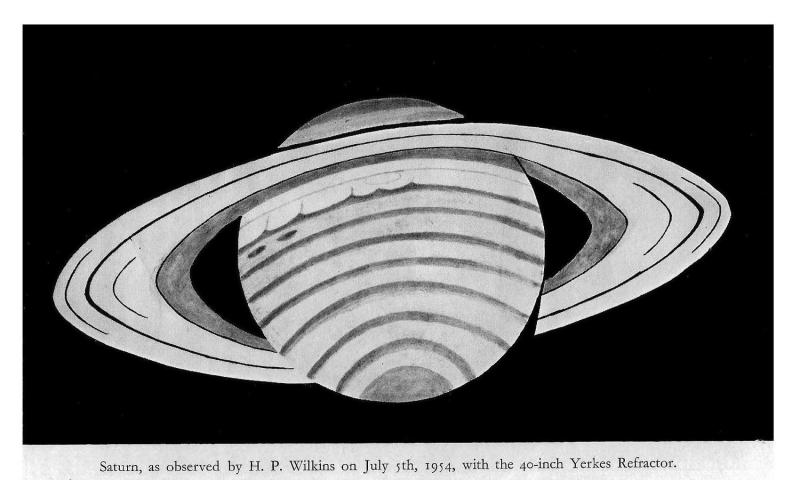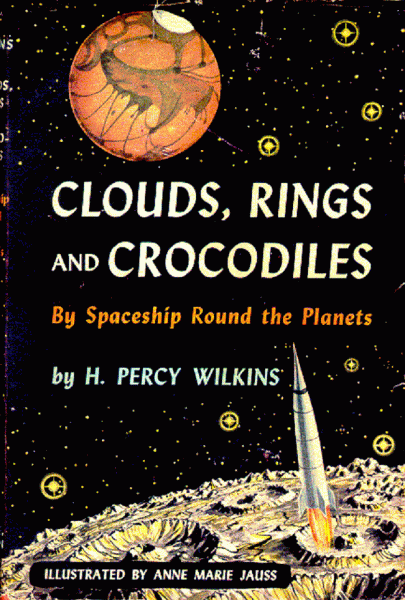From the BAA bookshelf
2021 October 3
Mysteries of Space & Time (1955) and Clouds, Rings & Crocodiles: by spaceship to the planets (1955), by H. P. Wilkins
One of the very first second hand books I ever purchased was Mysteries of Space & Time by Hugh Percival Wilkins (F. Muller, 1955). My copy says ‘Castle Bookshop, 1976’ on the flyleaf. (Ah! Those were the days when such bookshops were so much more plentiful than they are today…that very large one, since relocated and then a few years ago closed for good, was in my home town of Colchester.) Wilkins (1896–1960) was best known for his lunar work, but he was also involved in telescope making and education.

I was fascinated by the engaging descriptions of planets, and the drawings Wilkins made with large telescopes. Here are his descriptions of Mars in 1954 June, viewed with the 60-inch reflector at Mount Wilson: ‘…what was very unusual was the intense blueness of the markings, more especially the so-called seas in the southern hemisphere…That night only two of the canals could be seen, but it was clear that they were continuous streaks and not made up of a series of dots and dashes.’ With the 40-inch refractor at Yerkes, the circular dark patches, or oases, ‘suggested craters’. It is clear that Wilkins knew John Mellish, or at least had heard about his claims to have seen Martian relief features from the Yerkes Observatory many years earlier.

Though dated, and having an author who clearly believed in UFOs, this enjoyable little book got me interested in making my own planetary observations and later encouraged me to apply for time on large professional instruments. Alas! I have never managed to observe from Yerkes.

Clouds, Rings & Crocodiles: by spaceship to the planets was another intriguing 1950s book, this time part-reality-part-fantasy. It was intended for young readers interested in taking a trip around the solar system, and like the other book was written by Wilkins in the wake of his successful American lecture tour the previous year. Wilkins gave quite a surprising amount of technical detail about the rocket that his explorers used in their solar system trip. The BAA Library used to possess a copy of this book, though it no longer did by the time it was reduced to today’s small reserve collection. The explorers landed on the far side of the Moon, which was found to be similar to the near side, with lower mountains and less deep (volcanic) craters. The Moon-jeep with large wheels reminds us now of the Apollo programme. Less believable were the signs of moss-like vegetation and traces of past lunar inhabitants.
A contemporary book review revealed that the crocodiles of the title lived upon Venus, and I was sufficiently intrigued to buy my own copy in order to see a picture of them. Here I was to be disappointed. The crocodile-like creatures were not illustrated, and were spotted only in the distance by the intrepid explorers. Wilkins was ill-served by the artists who illustrated the British and American editions, published by Harrap. The UK artist was fair, but the American one was much worse and clearly did not comprehend the subject matter.
Both these books were unkindly savaged in lengthy reviews in our Journal, by D. W. Dewhirst and H. C. King respectively. Dewhirst was then a very young Director of the Solar Section, and to me it seems inappropriate that he should have criticised Wilkins, then in his tenth year as Director of the Lunar Section, in the sarcastic manner in which he did. King, soon to be the first Director of the London Planetarium, was becoming known for his somewhat acidic pen. Of course, Wilkins did tend to make loose statements, and sometimes lacked self-criticism in assessing his own observations, but I think the little books addressed the job for which they were intended: they interested young people, and inspired them to take a look for themselves. Nevertheless, with the unfortunate episode of O’Neill’s Bridge still playing itself out, it proved to be the moment for Wilkins to retire from the BAA scene.

For illustrations I have picked a sketch of Saturn from Mysteries, and I thought it would be nice to use an unpublished drawing by Wilkins from the Mars Section archives. But as a past Director of the Mercury & Venus Section I still regret not having seen those Venusian crocodiles…
Richard McKim, Archivist
| The British Astronomical Association supports amateur astronomers around the UK and the rest of the world. Find out more about the BAA or join us. |
